
NAME
r.colors.matplotlib - Convert or apply a Matplotlib color table to a GRASS raster mapKEYWORDS
raster, color table, matplotlibSYNOPSIS
Flags:
- -d
- Generate discrete color table
- Generate discrete (interval) color table instead of a continuous one
- -n
- Reverse the order of colors (invert colors)
- -g
- Logarithmic scaling
- -a
- Logarithmic-absolute scaling
- -e
- Histogram equalization
- --overwrite
- Allow output files to overwrite existing files
- --help
- Print usage summary
- --verbose
- Verbose module output
- --quiet
- Quiet module output
- --ui
- Force launching GUI dialog
Parameters:
- map=name[,name,...]
- Raster map(s) to apply color table to
- output=name
- Name for the new color table rules file
- color=string
- Name of color table
- Available color tables depend on the Matplotlib version. Alternatively this can be file name of a file generated by Python viscm tool
- ncolors=integer
- Number of colors in the color table
- Number of color intervals in a discrete color table with -d
- Options: 2-
- Default: 6
Table of contents
DESCRIPTION
The r.colors.matplotlib module converts Matplotlib color maps to GRASS color table format (rules) and assigns it to given raster map. The created color table is always relative (color rules with percent) When option map is specified r.colors.matplotlib assigns the color rules to the given raster map. The color tables is always stratched based on the range of values of the mapDepending on the use case, it may be advantageous to use the -d to discretize the color table into intervals.
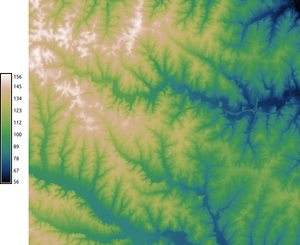
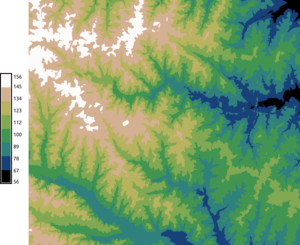
Continuous (default) and discrete (-d) color table
NOTES
This module depends on Matplotlib which needs to be installed on your computer. Use your Python package manager (e.g. pip) or distribution package manager to install it.The selection of color tables depends on the Matplotlib version. Note that the perceptually uniform sequential color tables, namely viridis, inferno, plasma, and magma, are available in Matplotlib 1.5 and above. Color tables are called color maps (or colormaps) in Matplotlib and the best overview of available color maps in the colormaps_reference example in Matplotlib documentation.
EXAMPLES
Creating a color table as GRASS color rules
Convert summer color table to GRASS color table rules format. If we don't specify output file, it is printed to standard output. We set number of colors to 2 because that's enough for this given color table (it has one color at the beginning and one at the end and linear interpolation can be used for the values in between).r.colors.matplotlib color=summer ncolors=2
0.000% 0:127:102 100.000% 255:255:102In case we want to use discrete color table with intervals with given constant color, we use the -d flag and the number of colors is now the number of intervals, so we want to make it higher, 5 in this case.
r.colors.matplotlib color=summer ncolors=5 -d
0.000% 0:127:102 20.000% 0:127:102 20.000% 63:159:102 40.000% 63:159:102 40.000% 127:191:102 60.000% 127:191:102 60.000% 191:223:102 80.000% 191:223:102 80.000% 255:255:102 100.000% 255:255:102
Setting color table for a raster map
Now we set several different color tables for the elevation raster map from the North Carolina sample dataset. We use continuous and discrete color tables (gradients). The color tables ae stretched to fit the raster map range.r.colors.matplotlib color=summer map=elevation r.colors.matplotlib color=winter ncolors=8 map=elevation -d r.colors.matplotlib color=autumn map=elevation r.colors.matplotlib color=cubehelix ncolors=8 map=elevation -d r.colors.matplotlib color=terrain map=elevation
d.legend raster=elevation labelnum=10 at=5,50,7,10

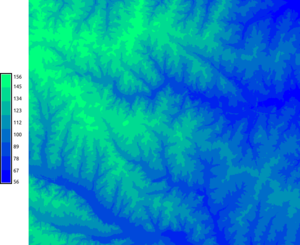
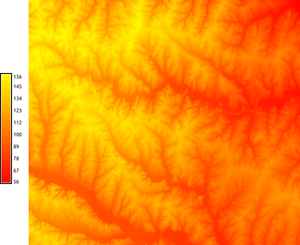
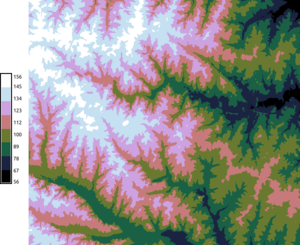

summer, winter, autumn, cubehelix, and terrain color tables applied to elevation raster from the North Carolina sample dataset. winter and cubehelix are set to be discrete instead of continuous.
Setting color table for a vector map
First we create a text file with color rules:r.colors.matplotlib color=summer output=mpl_summer.txt
v.colors map=points rules=mpl_summer.txt
Using color tables generated by the viscm tool
A viscm tool is a little tool for analyzing color tables and creating new color tables (color maps) for Matplotlib. The tool was used to create perceptually uniform color tables for Matplotlib (for example viridis). The new color table is stored into a file. In version 0.7, a temporary file named /tmp/new_cm.py which is a Python source code which creates a Colormap object. If this module gets a name of existing file instead of a color table name, it assumes that it this kind of file and reads object called test_cm as Matplotlib color table. The possible workflow follows. (Note that you need to install the viscm tool, e.g. using sudo pip install viscm on Linux.)Start the tool, create and save a color table:
python -m viscm edit
r.colors.matplotlib color=/tmp/new_cm.py rules=from_viscm.txt
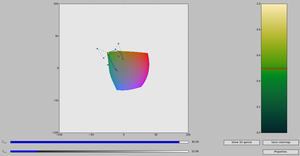
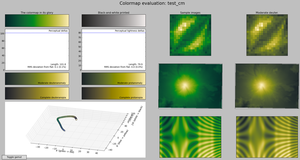
Editing color table in viscm (right): the yellow dot on the blue spline must stay in the colored area as the red line moves. Reviewing color table properties is done using several displays including color blindness simulations.
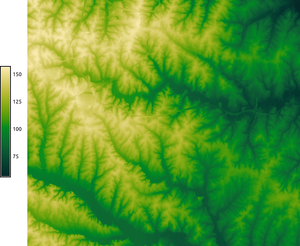
A color table from viscm applied to elevation raster from the North Carolina sample dataset.
SEE ALSO
r.colors, v.colors, r3.colors, r.cpt2grass, r.colors.cubehelixcolormaps_reference example in Matplotlib documentation
AUTHORS
Vaclav Petras, NCSU OSGeoRELLast changed: $Date: 2016-10-20 03:33:27 +0200 (Thu, 20 Oct 2016) $
SOURCE CODE
Available at: r.colors.matplotlib source code (history)
Main index | Raster index | Topics index | Keywords index | Graphical index | Full index
© 2003-2019 GRASS Development Team, GRASS GIS 7.4.5svn Reference Manual